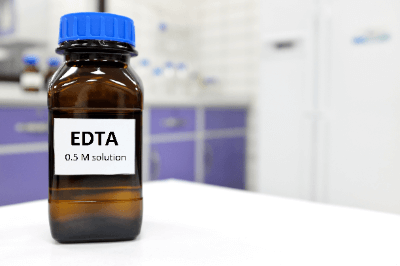What Is a Chelating Agent?
 Chelating Agents are agents that form complexes with metal ions, which cause various adverse effects, to reduce their activity.
Chelating Agents are agents that form complexes with metal ions, which cause various adverse effects, to reduce their activity.
There are various types of chelating agents, but basically they are based on an amino carboxylic acid structure, such as EDTA and DTPA, which are representative.
Amino carboxylic acid structure: refers to a structure with both an amino group (-NH2) and a carboxyl group (-COOH) in the molecule.
Uses of Chelating Agents
1. Industrial Applications
Chelating agents are used to balance solutions and adjust ion concentrations due to their high water solubility and stabilizing effects. Chelating agents that bind and react only with specific metals can also be used to recover valuable metals and sort and dispose of hazardous metals.
2. Medical Applications
Iron overload is a disease in which excess iron accumulates in the body for some reason, causing various symptoms such as fatigue and pain in body joints. Iron works well in moderate amounts, but its presence in excess has adverse effects.
Iron chelating agents are available to remedy this. The main ingredients are organic molecules such as deferoxamine and deferasirox. They form chelate complexes with iron and expel it from the body. In this way, metal components and radioactive substances that are present in excess in the body can be discharged and properly controlled.
3. Household Applications
Chelating agents are mainly added to dishwashing detergents and laundry detergents to protect the surfactants that control their cleaning performance from metal ions.
Properties of Chelating Agents
In the case of EDTA, the most typical chelating agent, the compound formed by the reaction of metal ions and the chelating agent is called a chelating complex, which remains soluble in the liquid without precipitation.
The complex is formed in a three-dimensional structure reminiscent of crab scissors, and the metal is trapped inside the complex, thereby exerting a metal sealing effect. The metal-blocking action refers to the ability to prevent other ions from binding to calcium ions and iron ions contained in water.
For example, laundry detergents contain chelating agents, which are intended to prevent negatively charged surfactants from binding with calcium and iron ions in tap water. Since surfactants are cleaning ingredients, their cleaning ability is significantly reduced when they bind with metal ions in the water. Therefore, to prevent metal ions from reactively binding with surfactants, Chelating agents with metal sequestering properties are added.
A wide variety of chelating agents such as EDTA, DTPA, and HEDTA can be selected according to the application. Since the type and performance of metal ions that coordinate and bind differ depending on the type, care and confirmation are required when selecting a chelating agent.
Types of Chelating Agents
There are many types of chelating agents used in foods, depending on the purpose and application. The four most common chelating agents are ethylenediaminetetraacetic acid, citric acid, phytic acid, and gluconic acid.
1. Ethylenediaminetetraacetic Acid (EDTA)
Two types of EDTA are designated as antioxidants: disodium EDTA and disodium calcium EDTA. They work to trap metal ions that promote oxidation. Some restrictions are placed on its use, and it can only be used in canned and bottled foods. Depending on the criteria for use, disodium EDTA must be inactivated by calcium disodium EDTA prior to completion of the final food product.
2. Citric Acid
Used as an acidifier to enhance the flavor of foods. It is well known as the main ingredient in citrus fruits such as lemons and oranges. It forms chelate complexes with minerals that enter the body, making them easier to absorb.
3. Gluconic Acid
Gluconic acid is used as a substitute for miso and salt. It is also widely used as an odor masking agent, pH adjuster, and discoloration inhibitor. It is added with ingredients such as sodium gluconate and glucono delta-lactone.
4. Phytic Acid
Utilized as an anti-discoloration agent, antioxidant, etc., this substance is abundant in rice bran and nuts. It forms and retains chelate complexes with minerals such as calcium, iron, copper, and zinc. There is concern that high content of this substance may inhibit the absorption of essential minerals because its chelating action becomes too strong.
Other Information on Chelating Agents
How to Calculate the Amount of Chelating Agent to Be Added
The chelation value (CV) is an indicator of the amount of metal ions with which a chelating agent can form complexes. This is defined by the number of mg of calcium carbonate that 1 g of chelating agent can form a coordination bond with, and the unit is mgCaCO3/g. In the case of EDTA-4H, the unit is mgCaCO3/g.
In the case of EDTA-4H, the CV is 342 mgCaCO3/g, and this value can be calculated as follows: EDTA and calcium ions bind 1:1, so 1 mol of calcium carbonate is required to saturate 1 mol of EDTA-4H with calcium ions.
Thus, if the molecular weight of calcium carbonate is 100 and that of EDTA-4H is 292, 1 g of EDTA-4H is needed to bind 342 mg of calcium carbonate.
Thus, if we know how much metal a chelating agent can sequester, we can calculate the approximate amount to be added when actually using the chelating agent.